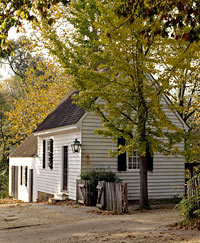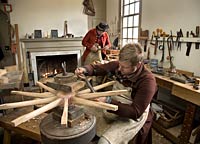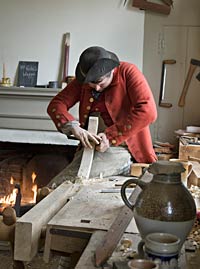Page content
Wheelwright
Wheels must be round above all else
Made of wood and bound with iron, the wheels of the carriages, wagons, and riding chairs that navigated rugged colonial roads had to be strong and tight. But first and foremost, the wheels had to be round.
Trade requires strength and precision
Producing wheels requires strength, ingenuity, and the talents of both a carpenter and a blacksmith. Precise measuring skills are mandatory.
Like their Williamsburg predecessors, the wheelwrights who practice the trade at the Deane Shop today start with a hub fashioned on a lathe from properly aged wood such as elm. A tapered reamer opens the center to receive a metal bearing; The wheelwright uses a chisel to create rectangular spoke holes around the circumference of the wheel. Carved from woods like ash, the spokes radiate to meet a rim of mortised wooden arches, called "fellies," that join to form a perfect circle.
Colonial tire made of iron
The blacksmith supplies a big hoop of iron precisely matched to the distance around the fellies. The wheelwright heats the iron tire, which expands just enough to be coaxed on with a heavy hammer. He then douses the wheel with water, which causes the iron tire to shrink a bit, which in turn binds the assembly.
The Deane Shop
Today the wheelwrights are located on Prince George Street in the Deane Shop, where carriages were made in the 18th century.



